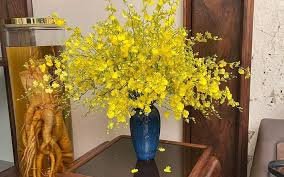**How to Grow Dancing Lady Orchids (Oncidium) Indoors: A Comprehensive Guide**

Growing Oncidium orchids, commonly known as Dancing Lady Orchids, can be a delightful experience. Known for their elegant, dance-like blooms and vibrant colors, these orchids can bring a touch of tropical beauty to any indoor space. However, cultivating them indoors requires specific knowledge about their ideal conditions, watering schedules, potting mix, and general care. This guide will provide you with an in-depth understanding of how to successfully grow Dancing Lady Orchids in your home, from selecting the right environment to troubleshooting common issues.
### 1. Understanding Oncidium Orchids: Characteristics and Indoor Growing Benefits
Oncidium orchids are a diverse group with over 300 species, native to Central and South America. They thrive in a range of climates from rainforests to mountainous regions. Their flowers, often in shades of yellow, orange, and red, resemble a lady in a flowing gown, which gives them their “Dancing Lady” nickname.
**Benefits of Growing Indoors:**
Growing Oncidium orchids indoors not only adds aesthetic value but also purifies indoor air, improves humidity, and reduces stress. The delicate appearance of these orchids combined with their relatively easy care requirements makes them ideal for indoor gardening enthusiasts.
### 2. Choosing the Right Location
The success of growing Oncidium orchids indoors largely depends on the environment you provide.
#### A. Light Requirements
Dancing Lady Orchids need plenty of indirect, bright light to thrive. Place them near an east or west-facing window where they can get morning or late afternoon sun. Avoid direct midday sunlight, as it can scorch their leaves.
– **Signs of Insufficient Light:** Dark green leaves indicate that the orchid needs more light.
– **Signs of Excessive Light:** Yellowish or reddish leaves can indicate that the plant is getting too much light.
Using sheer curtains can help diffuse the light if the sunlight is too strong. Alternatively, you can use artificial grow lights if natural light is limited in your space.
#### B. Temperature Preferences
Oncidium orchids prefer temperatures between 65°F and 75°F (18°C to 24°C) during the day and 55°F to 60°F (13°C to 16°C) at night.
These orchids are sensitive to sudden temperature changes, so avoid placing them near heating vents, radiators, or drafty windows. They can tolerate a slight dip in temperature at night, which mimics their natural habitat and encourages blooming.
### 3. Selecting the Ideal Potting Medium and Container
Unlike traditional soil, orchids require a specific type of potting medium that allows airflow to their roots.
#### A. Recommended Potting Medium
A well-draining medium such as a mixture of bark, perlite, and sphagnum moss is ideal. The bark provides aeration, while perlite and moss help retain moisture.
– **Option 1:** Orchid bark mixed with perlite for optimal drainage.
– **Option 2:** A ready-made orchid mix that combines bark, charcoal, and coco coir for better water retention and aeration.
#### B. Choosing the Right Pot
A pot with ample drainage is essential. Transparent plastic pots with multiple holes are often recommended, as they allow you to monitor root health and help the roots photosynthesize, which orchids appreciate.
Clay pots are also an excellent choice because they offer better breathability, although they may require slightly more frequent watering.
### 4. Watering Oncidium Orchids
Oncidium orchids prefer a consistent watering routine but are sensitive to overwatering. They generally require less water than many other orchid varieties.
#### A. Frequency and Method
– **Frequency:** Water your orchid about once a week, adjusting based on seasonal changes. During warmer months, you may need to water more frequently, while in winter, water less often.
– **Method:** A recommended watering method is to soak the potting medium thoroughly, letting excess water drain out completely. Avoid letting the plant sit in water, as this can lead to root rot.
#### B. Water Quality
Use filtered, distilled, or rainwater if possible. Tap water often contains minerals and chemicals like chlorine, which can accumulate in the soil and harm the orchid over time.
#### C. Humidity Needs
Oncidium orchids prefer moderate humidity levels around 40-60%. Indoor heating and cooling systems can reduce humidity, so consider using a humidity tray or a small room humidifier to maintain the ideal level.
### 5. Fertilizing Your Dancing Lady Orchid
Feeding your orchid is essential to promote healthy growth and blooms.
#### A. Types of Fertilizers
Choose a balanced, water-soluble orchid fertilizer (such as 20-20-20 or similar). You can also use a urea-free fertilizer specifically formulated for orchids, as this helps avoid root burn and encourages better nutrient absorption.
#### B. Fertilizing Schedule
Feed your orchid every 2 to 3 weeks during the growing season (spring and summer). Reduce feeding during fall and winter when the orchid’s growth slows down.
**Tip:** Use a “weekly, weakly” approach, diluting the fertilizer to half or quarter strength, which prevents over-fertilization and helps the plant absorb nutrients gradually.
### 6. Repotting Oncidium Orchids
Repotting helps refresh the potting medium, prevents root crowding, and supports the plant’s health.
#### A. When to Repot
Repot your orchid every 1 to 2 years or when the potting medium breaks down. Repotting should ideally be done in the spring, just as new growth appears.
#### B. Steps to Repotting
1. **Remove the Orchid:** Gently remove the orchid from its current pot, taking care not to damage the roots.
2. **Trim Dead Roots:** Trim away any dead, mushy, or brown roots using sterilized scissors.
3. **Refresh the Medium:** Place the orchid in fresh potting medium, ensuring the base of the plant sits just above the medium.
4. **Water Sparingly:** After repotting, water sparingly for the first week to help the roots adjust to the new medium.
### 7. Promoting Flowering in Oncidium Orchids
Encouraging your Oncidium orchid to bloom indoors requires providing the right balance of light, temperature, and care.
#### A. Cool Night Temperatures
A slight drop in temperature at night (about 10°F cooler than daytime) can stimulate flowering. Place the orchid near a slightly cooler window if possible.
#### B. Patience and Consistency
Oncidium orchids bloom once a year, typically in late winter or early spring. Consistent care and a stable environment will eventually reward you with beautiful, dance-like blooms.
### 8. Common Issues and Troubleshooting
#### A. Yellowing Leaves
– **Cause:** Overwatering, low light, or nutrient deficiency.
– **Solution:** Adjust watering practices, improve light exposure, and consider applying a balanced fertilizer.
#### B. Root Rot
– **Cause:** Poor drainage or overwatering.
– **Solution:** Ensure the potting medium and pot allow for proper drainage, and let the medium dry slightly between waterings.
#### C. Lack of Flowers
– **Cause:** Insufficient light or improper temperature fluctuations.
– **Solution:** Adjust lighting conditions and try to create a small temperature drop at night.
#### D. Pest Infestations
– **Common Pests:** Aphids, spider mites, and scale.
– **Solution:** Wipe the leaves with a mild soapy water solution or use insecticidal soap. Regularly check your plants for pests to catch infestations early.
### 9. Creating a Display and Caring for Multiple Oncidium Orchids Indoors
Arranging multiple orchids together not only enhances indoor aesthetics but also helps maintain humidity levels. Create an orchid display by grouping pots on a humidity tray or placing them in a decorative indoor greenhouse cabinet. This setup makes it easier to manage their light, temperature, and humidity requirements.
### 10. Benefits of Growing Oncidium Orchids Indoors
Growing Oncidium orchids indoors offers more than just visual appeal. These orchids contribute to air quality, reduce indoor stress, and provide a rewarding gardening experience. Their beauty and grace make them a focal point in any room, bringing a piece of tropical elegance into your home.
### Conclusion
Cultivating Dancing Lady Orchids indoors can be a gratifying journey for plant enthusiasts. With proper care, these orchids will thrive and bloom, showcasing their dance-like flowers year after year. Whether you’re a seasoned orchid grower or a beginner, the beauty and resilience of Oncidium orchids will make them a cherished addition to your indoor garden.

